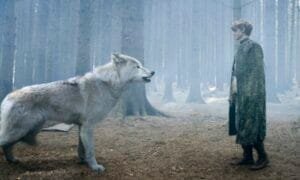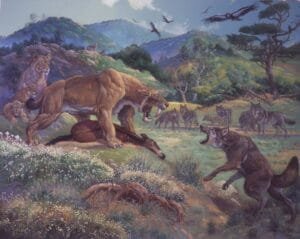
Colossal’s Dire Wolf De-Extinction: Milestones, Moral Questions, and Scientific Breakthroughs
The notion of bringing back an extinct apex predator once confined to the pages of paleontology textbooks is no longer science fiction. In 2025, Colossal Bioscience announced the successful birth of gray wolves genetically modified to express traits of the prehistoric dire wolf. This landmark achievement in genetic engineering has ignited global excitement—and heated debate—over the ethics and ecological implications of de‑extinction. In this comprehensive guide, we’ll trace the dire wolf’s journey from Ice Age icon to modern genetic marvel, unpack the science and controversies, and explore what the future may hold.
What You’ll Learn
- The natural history and extinction of the dire wolf.
- Colossal Bioscience’s mission and team behind the project.
- Step‑by‑step genetic engineering methods used to recreate dire wolf traits.
- Key milestones and the birth of the first “dire wolf‑like” pups.
- Ethical debates surrounding de‑extinction and animal welfare.
- Ecological, regulatory, and conservation implications.
- Public perception, cultural impact, and indigenous perspectives.
- FAQs addressing common questions and concerns.
1. The Dire Wolf’s Origins and Extinction
1.1 Who Were the Dire Wolves?
The dire wolf (Aenocyon dirus) roamed North America and parts of South America until roughly 12,500 years ago. These formidable canids were up to 25% larger than modern gray wolves, with robust jaws capable of crushing bone. Fossil evidence from the La Brea Tar Pits reveals that dire wolves hunted megafauna—bison, horses, and even young mammoths—playing a crucial role as apex predators in Pleistocene ecosystems .
1.2 Why Did Dire Wolves Vanish?
Climate change at the end of the last Ice Age, combined with human expansion and the extinction of large prey species, led to the dire wolf’s decline. As megafauna disappeared, dire wolves lost their primary food source. Competition with more adaptable gray wolves may have further hastened their extinction.
1.3 How They Went Extinct?
- Climate Change at the Pleistocene–Holocene Transition:
Rapid warming ~12,700 years ago altered habitats and reduced cold‑adapted megafauna prey. - Human Hunting Pressure:
Arrival of Paleo‑Indians with sophisticated hunting tools increased predation on both dire wolves and their prey. - Loss of Megafauna Prey:
As bison, horses, and other large herbivores declined, dire wolves lost their primary food sources. - Ecosystem Shifts & Competition:
Changing vegetation patterns and competition with other predators (e.g., gray wolves, early humans) further stressed populations.
1.4 Why Revive the Dire Wolf?
Proponents of de‑extinction argue that reintroducing the dire wolf could restore lost ecological functions—controlling overpopulated herbivores and rebalancing predator‑prey dynamics. For Colossal Bioscience, the project also demonstrates the power of genetic engineering to conserve biodiversity and reverse human‑driven extinctions.
2. Colossal Bioscience: Pioneers of De‑Extinction

2.1 The Company and Its Vision
Founded in 2021 by geneticist George Church and tech entrepreneur Ben Lamm, Colossal Bioscience aims to use genetic engineering to bring back extinct species and combat biodiversity loss. After initial work on woolly mammoths, the company turned to the dire wolf as its first de‑extinction target.
2.2 Leadership and Partnerships
- George Church: Harvard professor renowned for CRISPR innovations.
- Ben Lamm: Serial entrepreneur with a passion for biotech applications.
- Partners: Collaboration with Revive & Restore, the Vertebrate Genomes Project, and multiple academic labs to access ancient DNA and refine gene‑editing protocols .
2.3 Funding and Scale
Backed by Bridgewater Associates, Lux Capital, and other investors, Colossal Bioscience has raised over $200 million. This funding supports large‑scale laboratory operations, field testing, and public education initiatives.
3. The Science of Dire Wolf De‑Extinction

3.1 CRISPR and Ancient DNA
Genetic engineering for de‑extinction begins with extracting fragmentary DNA from dire wolf fossils. Using CRISPR/Cas9, scientists edit gray wolf genomes, inserting or modifying key genes linked to size, jaw strength, fur color, and other dire wolf traits .
3.2 Identifying Dire Wolf Genes
Comparative genomics pinpoints 14 genes that differ significantly between gray wolves and dire wolves. Colossal’s team synthesized functional versions of these genes and integrated them into wolf embryonic cells.
3.3 Embryo Editing and Surrogate Birth
Edited embryos were implanted into gray wolf surrogates. In early 2025, three pups—Romulus, Remus, and Khaleesi—were born exhibiting white fur, robust skull shapes, and pink ears reminiscent of fossil reconstructions . While genetically gray wolves, these hybrids express roughly 95% of the targeted dire wolf traits.
4. Milestones and Controversies
4.1 Key Project Timeline
- October 2024: Birth of Romulus and Remus, the first hybrid pups.
- January 2025: Arrival of Khaleesi, the first female hybrid .
- April 2025: Public announcement and peer discussions at scientific conferences.
4.2 Scientific Achievements
- First application of large‑mammal de‑extinction via CRISPR.
- Demonstration that targeted gene edits can recapitulate ancient phenotypes.
- Development of protocols for scaling de‑extinction efforts to other species.
4.3 Skepticism and Debate
Critics—including zoologist Philip Seddon and paleogeneticist Nic Rawlence—argue these animals are not true dire wolves but engineered gray wolves with superficial traits. They point out that only ~5% of the dire wolf genome is known, and editing 14 genes cannot recreate the full species .
5. Ethical Questions and Animal Welfare

5.1 “Is It True De‑Extinction?”
Some experts call Colossal’s hybrids “reconstructions,” not de‑extinctions, since vast portions of the genome remain unedited. This raises ethics concerns about misrepresenting scientific achievements.
5.2 Playing God vs. Conservation
Is reviving extinct species an act of stewardship or hubris? Proponents argue that humans have a moral obligation to correct past extinctions. Opponents counter that resources should focus on saving currently endangered species rather than resurrecting the past.
5.3 Animal Welfare and Health
Gene editing can produce unintended effects—skeletal deformities, organ issues, or shortened lifespans. Ensuring the well‑being of hybrid animals is a critical ethics concern. Colossal has committed to transparent health monitoring, but peer‑reviewed data is still pending.
6. Ecological and Conservation Implications
6.1 Ecosystem Restoration
Reintroducing dire wolf‑like predators could curb overgrazing by deer and other herbivores, potentially restoring plant diversity. However, modern ecosystems have shifted—large prey species no longer exist, so hybrids may rely on human‑provided food.
6.2 Regulatory Hurdles
No international framework governs de‑extinction. In the U.S., the Endangered Species Act may classify hybrids as “experimental,” limiting their release. Regulatory clarity is essential before any wild introductions.
6.3 Indigenous and Local Perspectives
The Mandan, Hidatsa, and Arikara Nation have expressed interest in controlled releases on tribal lands, viewing the dire wolf as part of ancestral heritage. Respecting indigenous sovereignty and knowledge is crucial in any release plan .
7. Future Prospects: Beyond the Dire Wolf
7.1 Scaling De‑Extinction
Colossal plans to apply genetic engineering techniques to passenger pigeons, woolly mammoths, and even the Tasmanian tiger. Each species presents unique genomic challenges, but the dire wolf project serves as a proof of concept.
7.2 Medical and Agricultural Spin‑Offs
CRISPR advances from de‑extinction may yield medical breakthroughs—gene therapies for genetic disorders—and agricultural benefits like disease‑resistant livestock.
7.3 Balancing Innovation and Conservation
The de‑extinction debate underscores a broader question: How can cutting‑edge science support biodiversity without overshadowing urgent conservation of living species?
8. FAQs on Dire Wolf De‑Extinction
Q1: What exactly is a dire wolf hybrid?
A: A gray wolf genetically edited to express select dire wolf traits—size, skull shape, fur color—via CRISPR. They’re not true clones but phenotypic reconstructions .
Q2: How many dire wolf genes are known?
A: Scientists have identified roughly 14 key genes linked to dire wolf characteristics. Full genome sequences remain incomplete.
Q3: Could these hybrids survive in the wild?
A: Unlikely without their original megafauna prey. Initial plans keep hybrids in controlled preserves.
Q4: What are the main ethical concerns?
A: Animal welfare risks, resource allocation away from endangered species, and the question of “playing God” in rewriting evolution.
Q5: How does this project help conservation?
A: It advances genetic engineering tools that could restore endangered species’ genetic diversity and resilience.
9. Conclusion
The dire wolf de‑extinction project by Colossal Bioscience marks a bold frontier in genetic engineering, blending paleogenomics with modern biotech. While the births of Romulus, Remus, and Khaleesi demonstrate remarkable scientific progress, the ethics and ecological ramifications demand careful scrutiny. As the debate unfolds, public engagement and transparent research will be vital to ensuring that de‑extinction serves both science and society.
Join the Conversation:
Is bringing back the dire wolf worth the risk? Share your thoughts below and follow us for updates on this groundbreaking journey.
10. References
1. NPR: A biotech company says it has bred three animals with key physical features of the dire wolf
2. Wikipedia: Romulus, Remus, and Khaleesi – genetically modified gray wolves with dire wolf traits
3. Wikipedia: Colossal Bioscience company overview and expert criticisms
NOTE:
Have Questions?
Feel free to leave a comment on the post! Our team is here to respond to your queries as quickly as possible.
Thank You for Visiting Questinate!
We’re thrilled to have you explore our site for tips, knowledge, and insights. Stay updated with fresh, valuable blogs by visiting us daily.
Spread the Word!
If you found this helpful, share it with your friends and family: Questinate – Explore, Learn & Enjoy
Contact Us!
If you have any query, Contact Us – Questinate we are happy to assist you.
We look forward to seeing you again soon!
SUBSCRIBE TO OUR Newsletter – Questinate!


They are so cuteee….💌